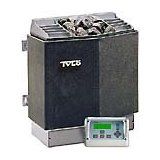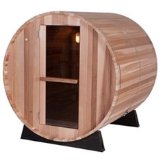Common Infrared Sauna FAQs
We've gathered together some common infrared sauna FAQs and answered them as simply as possible so that you can take that information and use it to decide whether infrared sauna use is right for you.
What is an Infrared Sauna?
Infrared saunas use electromagnetic waves to heat the body directly. The wavelength of infrared rays is invisible, unlike sunlight. Infrared rays don't contain any ultraviolet waves and are safer than microwaves. The infrared heat is absorbed by the body, creating a warm, relaxed feeling and encouraging blood circulation and healing.
How is an Infrared Sauna Different from a Steam Sauna?
In a traditional sauna, the air and steam around you is super-heated. The heat is then transferred from the air and steam to your body. Infrared heat doesn't heat the air around you and doesn't use steam. It makes for a much more efficient sauna experience, as more than 90% of infrared heat is absorbed by the body rather than being wasted in the surrounding air.
What is the Temperature of an Infrared Sauna?
This
is one of the most asked of the many infrared sauna FAQs, and for good reason.
Infrared saunas don't reach the same temperatures as steam saunas, which need
to work harder to produce a sweat and heat the body. Infrared saunas should be
set at temperatures between 110° and 130° Fahrenheit, while traditional saunas
range anywhere from 160° to 200° Fahrenheit. Because your body will produce the
same sweat and feel just as warmed with lower infrared temperatures, it is
safer and gentler.
What are the Benefits of an Infrared Sauna?
Any time infrared sauna FAQs are put together, a question about the benefits comes up. While the purported benefits of using an infrared sauna vary depending on who you talk to, there are several benefits that most doctors agree on. When your body is warmed, blood vessels and capillaries dilate, increasing the circulation of blood. You'll also break into a sweat that will flush toxins out of your body through your skin. Finally, your metabolic rate will increase. As a result of these physiological changes, you can expect some definite health benefits with regular infrared sauna use:
- Clearer, more radiant skin
- Weight loss due to your increased metabolism
- Improved circulation
- Improved immune system response
- Decreased pain, particularly for chronic pain conditions
- Improved healing
Some irresponsible infrared sauna FAQs will claim that using a sauna can "cure" certain diseases. Don't trust these claims; while saunas can greatly reduce symptoms, they are not cure-alls.
How Often and for How Long Can You Use an Infrared Sauna?
If you're new to using a home infrared sauna, be sure you check with your doctor first to get a clean bill of health. If you get his or her okay, you can start by using the sauna for ten to fifteen minutes each session, two or three times a week.
Eventually, you can work up to sessions of up to 45 minutes and, if you like, step into your infrared sauna every day. For most people, however, three or four sessions of about a half hour each seems to offer the most benefits.
We discuss how long you should stay in the sauna in more depth here.
Is There Anyone Who Shouldn't Use an Infrared Sauna?
There is no reputable list of infrared sauna FAQs that doesn't address the problem of who shouldn't use this healthy form of relaxation. There are some contraindications for sauna use that everyone should keep in mind:
- If you have a recent injury such as a sprain, don’t use a sauna because the heat could increase inflammation, particularly of injured joints. After 48 hours, however, the infrared waves can actually promote faster healing.
- If you are pregnant, you should avoid using any form of sauna unless under a doctor's advice and supervision.
- Hemophiliacs and individuals who are prone to hemorrhaging should not use an infrared sauna.
To learn more, visit manufacturers' websites and check out their own infrared sauna FAQs.






